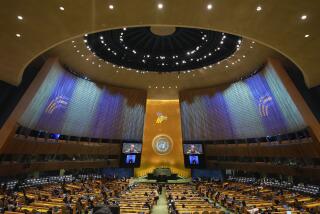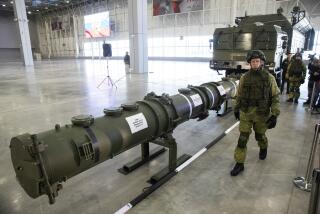THE WASHINGTON SUMMIT : NEWS ANALYSIS : START Pact May Fool Critics of Arms Control : Treaty: The agreements mark the beginning of the critical task of dismantling ‘over-armament’ that accumulated during four decades of confrontation.
- Share via
WASHINGTON — Critics of arms control have long complained that “when it’s important, it’s not do-able, and when it’s do-able, it’s not important.” But President Bush and Soviet President Mikhail S. Gorbachev took a significant step Friday toward proving the critics wrong.
The agreements that they signed on strategic nuclear weapons, chemical weapons and nuclear testing, along with a joint statement advancing prospects for conventional force cuts in Europe, mark the beginning of the critical task of dismantling the “over-armament” of both nuclear and conventional weapons that accumulated during four decades of confrontation.
“The START treaty will signal a turning point in U.S.-Soviet arms control efforts toward a more rational, open, cooperative, predictable and stable relationship,” the two leaders said in a statement accompanying the agreement.
Said Bush: “The world has waited long enough. The Cold War must end.”
The START pact, in particular, will cut in half the number of missile warheads, the most dangerous weapons on both sides, and the reductions will be verified by 13 different types of on-site inspection. Also, it switches the weight of the arsenals from fast-flying ballistic warheads to slow-flying cruise missile warheads.
“No one is going to start a war by using cruise missiles,” said former arms negotiator Paul C. Warnke.
Beyond that, START could significantly increase political stability between the two countries, according to Harvard Prof. Joseph S. Nye, Jr.
“The basic objective of arms control,” he said, “has been to promote stability, with reduced risk of conflict and some money saving. START, as it emerges, does advance those goals and thus sets the stage for the next steps in the process, including deeper cuts in nuclear weapons.”
“Maybe this disarmament process is a victim of its own success,” said Soviet Foreign Ministry spokesman Gennady I. Gerasimov, tacitly acknowledging the grumbling of critics over Friday’s arms agreements. “We used to talk a lot about disarmament, and now when we have disarmament we talk less.
“It doesn’t mean that it has less significance,” Gerasimov added, referring to the anticipated START pact. “It’s extremely significant. It also gives you and us a peace dividend.”
Certainly critics can argue that there is room for improvement in the accords: The cuts could have been deeper, negotiations less protracted. But they set the stage, militarily and politically, for the next steps in slowing down the arms race.
The START agreement will cut offensive nuclear arsenals by one-third overall, not by the flat 50% once promised. And it will take seven years to get the weapon stockpiles back to roughly their size when the strategic arms reduction talks began in 1982.
But even some who are disappointed at the “modest” size of the cuts, like Warnke, a former arms negotiator, see the treaty as a “useful” step.
The anticipated treaty to cut conventional forces in Europe (CFE) has generally drawn less criticism. The Warsaw Pact countries would cut four times more weapons from their arsenals than the North Atlantic Treaty Organization: 15% to 60% of various weapon categories, compared to 7% to 15% for NATO.
Instead of taking eight years to negotiate, CFE promises to be finished in only two. But here, too, critics complain that history has moved faster than arms control and that the weapon and troop ceilings set by the agreement could become the floors that the Soviets will insist upon retaining in East Europe in the future.
Barring some drastic reversal of the present flow of events, however, there seems little realistic prospect that any significant Soviet presence will remain in the former Soviet Bloc countries by the end of the treaty’s seven-year reduction period.
Hungary and Czechoslovakia will be rid of the Soviets by mid-1991. Poland may or may not allow small contingents of Soviet logistic troops to stay to service Soviet forces in East Germany. But with German unification imminent, Soviet troops can only be marking time on East German territory before they depart.
The CFE treaty, further, will require the destruction of massive amounts of weapons--over 100,000 tanks, artillery and aircraft by the Warsaw Pact. Reconstituting them in order to go to war would be very costly and time-consuming, and probably could not be done without alerting the West.
So the CFE accord should largely blow away the specter of a big conventional war in Europe for decades. As such, it will have more immediate impact on the Continent than will the START pact.
But the superpowers will still be overstocked with nuclear weapons whose use, while far less likely, can obliterate the world. Hence new negotiations, to quickly follow completion of the START treaty, will seek “to enhance stability and reduce the risk of war,” Bush said at Friday’s White House signing ceremony.
Arms control experts have a more specific list than that already prepared.
A primary goal should be to reduce the weapon totals further, to 3,000 or 4,000 weapons, according to Harvard’s Nye. The START treaty now anticipated will permit 6,000 “accountable” weapons, but it will actually permit 9,000 or slightly more because of liberal counting rules for cruise missiles. The next treaty should set a limit that will have no loopholes, Nye said.
The new talks are certain to seek strict limits on the number of land-based intercontinental missiles with multiple warheads. Both U.S. and Soviet officials agree that such missiles are destabilizing: They are the best weapons to launch a surprise attack, and also the most attractive targets in a surprise attack.
Another goal will be further cuts in the very large Soviet ICBM missiles, the SS-18s, whose power and accuracy are the most threatening to the United States.
Curbs on nuclear weapons in naval forces will be a topic pushed by the Soviets in future talks, because they fear that nuclear weapons on U.S. submarines and ships can circumvent the START treaty.
COUNTING NUCLEAR WARHEADS The goal of the START agreement under negotiation is to reduce the nuclear arsenal of each superpower below 6,000 warheads. Below are current and anticipated levels by 1998, including intercontinental ballistic missiles (ICBMs), submarine-launched ballistic missiles (SLBMs) and nuclear devices carried on bombers. ICBMs Currents levels United States: 2,450 Soviet Union: 6,450 Post-START levels United States: 1,800 Soviet Union: 3,050 SLBMs Currents levels United States: 5,024 Soviet Union: 3,642 Post-START levels United States: 3,024 Soviet Union: 1,848 BOMBERS Currents levels United States: 4,500 Soviet Union: 1,228 Post-START levels United States: 1,083 Soviet Union: 1,085 TOTAL Currents levels United States: 11,974 Soviet Union: 11,320 Post-START levels United States: 5,907 Soviet Union: 5,983 Source: Natural Resources Defense Council
More to Read
Sign up for Essential California
The most important California stories and recommendations in your inbox every morning.
You may occasionally receive promotional content from the Los Angeles Times.











